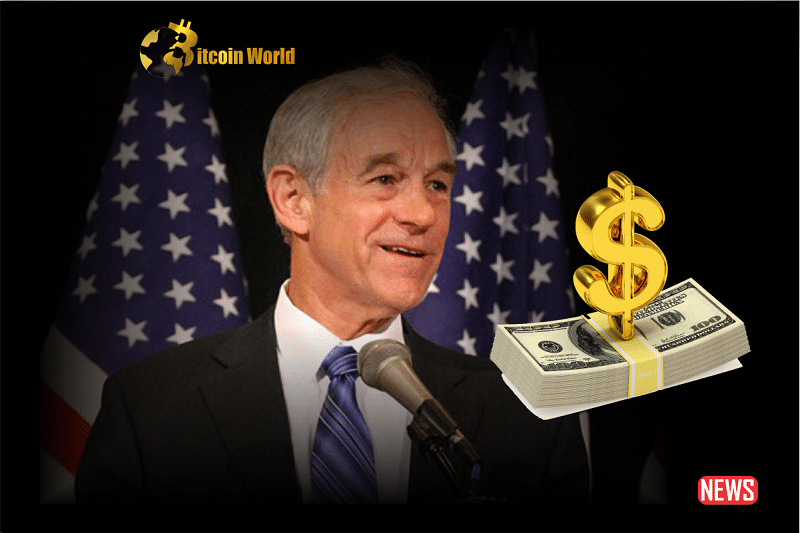Is the foundation of your financial world about to shift? Former US Congressman Ron Paul has sounded the alarm, predicting a significant downturn for the US dollar. His reasoning? The ever-mounting national debt. For those keeping a close eye on the global economy, especially those involved in the dynamic world of cryptocurrencies, this warning raises crucial questions about the future of fiat currencies and the potential for alternative financial systems.
Why is Ron Paul So Concerned About the US Dollar?
Paul, a well-known constitutionalist and libertarian, doesn’t mince words. He believes the current trajectory of the US dollar is unsustainable. His core arguments, shared on his popular YouTube channel, center around:
- Soaring National Debt: The US national debt is reaching unprecedented levels, and the interest payments alone are projected to climb into the trillions. Paul argues this is a clear indicator of an unsustainable financial path.
- Erosion of Confidence: He points to growing unease among central banks and even private citizens who are increasingly turning to gold as a safe haven asset. This shift in sentiment suggests a weakening faith in the dollar’s long-term stability.
- Historical Precedent: Paul emphasizes that, historically, most fiat currencies have a limited lifespan. He sees the dollar as no exception to this rule.
The Bretton Woods Agreement: A Foundation Under Scrutiny?
Paul highlights the significance of the 1944 Bretton Woods agreement. This landmark accord established the US dollar as the world’s reserve currency. However, he suggests that the seeds of the dollar’s potential decline were sown even then. The agreement, while providing stability for a period, ultimately tied the global monetary order to a single nation’s currency, making it vulnerable to that nation’s economic policies and debt levels.
What Does the Rising National Debt Mean for the Dollar?
Think of it like this: imagine a household with ever-increasing credit card bills and minimal income growth. Eventually, that household will face a financial reckoning. Paul argues the US is in a similar situation. The sheer magnitude of the national debt and the escalating interest payments raise serious concerns. As Paul succinctly puts it, “anyone with basic economic knowledge can see that such a trajectory is unsustainable and cannot continue indefinitely.”
Is the Reign of the Dollar Truly Coming to an End?
While Paul paints a concerning picture, the transition to a new global reserve currency is no simple feat. Here’s a breakdown of the complexities:
- A Lengthy Process: Paul acknowledges that replacing the dollar won’t happen overnight. It’s a complex and gradual process.
- Existing Dominance: The US dollar currently holds a dominant position in global finance, used in a vast majority of international transactions and held by central banks worldwide. Overcoming this entrenched position requires significant shifts in global economic power and trust.
- Diversification is Underway: Despite the hurdles, the trend of central banks and individuals diversifying their holdings by acquiring gold and expressing skepticism about the dollar is a notable development. This suggests a proactive move to hedge against potential dollar devaluation.
What are the Potential Impacts of a Dollar Downturn?
The implications of a significant dollar downturn are far-reaching. Here are some potential consequences:
- Increased Inflation: A weaker dollar could lead to higher import costs, potentially fueling inflation within the US.
- Shifting Global Power Dynamics: A decline in the dollar’s dominance could reshape the global economic landscape, potentially empowering other nations and currencies.
- Uncertainty in Financial Markets: A major shift in the global reserve currency could create volatility and uncertainty in financial markets worldwide.
- Opportunities for Alternative Assets: As confidence in the dollar wanes, alternative assets like gold and potentially even cryptocurrencies could see increased demand.
Navigating the Future: What Can Be Done?
While predicting the future with certainty is impossible, understanding the potential risks is crucial. Here are some actionable insights:
- Stay Informed: Keep abreast of global economic trends and the discussions surrounding the future of the dollar.
- Diversify Investments: Consider diversifying your investment portfolio beyond traditional dollar-denominated assets. This could include exploring precious metals or other currencies.
- Understand the Role of Cryptocurrencies: While not a direct replacement for a reserve currency yet, understand the potential role of decentralized digital currencies in a changing financial landscape.
Conclusion: A Call for Vigilance and Preparedness
Ron Paul’s warning serves as a stark reminder of the potential vulnerabilities within the current global financial system. While the dollar’s decline is not guaranteed, the factors he highlights – the soaring national debt and the eroding confidence – are significant concerns. The transition to a new global reserve currency, should it occur, will be a complex and lengthy process. However, the ongoing diversification by central banks and individuals suggests a growing awareness of the potential for change. Staying informed, understanding the risks, and considering diversification are crucial steps for navigating the evolving financial landscape. The future of the global monetary system is uncertain, but one thing is clear: the conversation about the dollar’s long-term viability is gaining momentum.
Disclaimer: The information provided is not trading advice, Bitcoinworld.co.in holds no liability for any investments made based on the information provided on this page. We strongly recommend independent research and/or consultation with a qualified professional before making any investment decisions.


